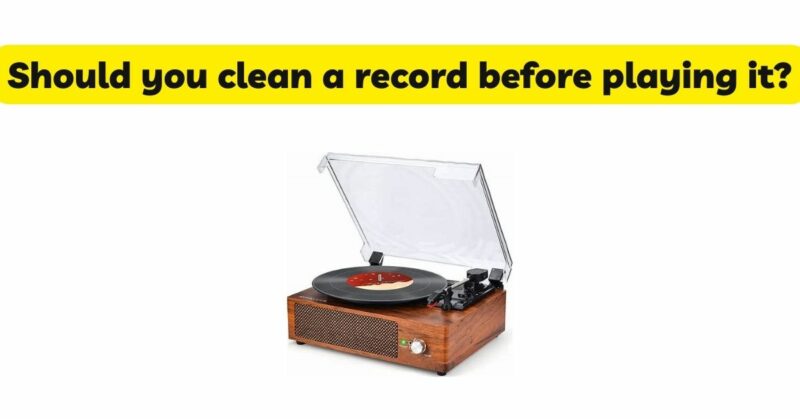Vinyl records have experienced a remarkable resurgence in recent years, captivating music enthusiasts with their warm sound and nostalgic charm. However, the quality of the vinyl playback experience can be greatly affected by the cleanliness of the records themselves. The question arises: should you clean a record before playing it? In this article, we will explore the importance of pre-playback cleaning, discussing the reasons behind it and providing insights into effective cleaning methods.
The Impact of Dust and Debris: Dust and debris are common culprits that can compromise the sound quality of vinyl records. When a stylus runs over a dirty or dusty record, it picks up these particles, resulting in audible pops, clicks, and background noise. The presence of dust can also cause the stylus to skip or jump, disrupting the smooth playback experience. Therefore, cleaning a record before playing it is essential to reduce these undesirable effects and ensure optimal audio reproduction.
Preservation of the Stylus and Records: The stylus, also known as the needle, is a delicate component that makes direct contact with the record’s grooves. Dust particles and debris on the record surface can be abrasive, causing unnecessary wear on both the stylus and the record. By cleaning the record before playing it, you minimize the risk of the stylus encountering these contaminants, prolonging its lifespan and preserving the condition of your records.
Enhancing Sound Quality: A clean record surface allows the stylus to make precise and accurate contact with the grooves, resulting in improved sound quality. Dust particles on the record can cause distortions and muffled sound reproduction. Cleaning the record removes these impediments, allowing for clearer, more detailed playback. By investing time in pre-playback cleaning, you can truly appreciate the full potential of your vinyl collection and enjoy a superior listening experience.
Different Cleaning Methods: There are various methods available for cleaning vinyl records, ranging from simple dry brushing to more advanced wet cleaning techniques. Here are some commonly used methods:
a. Dry Brushing: A carbon fiber brush or an anti-static brush is an effective tool for removing loose particles from the record surface. Gently sweep the brush along the grooves in a circular motion to dislodge dust and debris. This method is quick and convenient for routine maintenance.
b. Record Cleaning Solutions: For a more thorough cleaning, specially formulated record cleaning solutions can be used. Apply the cleaning solution to a microfiber cloth or a soft brush and gently wipe the record surface, following the grooves. These solutions help dissolve and lift stubborn dirt and grime, providing a deeper clean.
c. Record Cleaning Machines: Record cleaning machines offer a more advanced and comprehensive cleaning solution. These machines use a combination of brushes, cleaning solutions, and vacuum suction to remove dirt and contaminants from the record surface. While more expensive and time-consuming, record cleaning machines can deliver superior results, especially for heavily soiled records.
Proper Cleaning Techniques: Regardless of the cleaning method you choose, it’s important to follow proper techniques to avoid damaging the record or stylus. Here are some tips to keep in mind:
a. Handle with Care: Always handle records with clean hands or wear record gloves to prevent transferring oils or dirt to the record surface. Hold records by their edges or inner labels to avoid touching the playing surface.
b. Gentle Pressure: Apply gentle pressure when cleaning the record to avoid scratching or damaging the grooves. Let the cleaning solution or brush do the work, and avoid excessive force.
c. Follow the Grooves: When cleaning, always follow the direction of the grooves. Wipe or brush in a circular motion along the grooves to dislodge dirt effectively.
d. Allow Drying Time: If you use a wet cleaning method, allow the record to dry completely before playing it. Moisture can affect playback and potentially damage your turntable or stylus.
Frequency of Cleaning: The frequency of record cleaning depends on various factors, including the environmental conditions, handling practices, and the record’s condition. As a general rule, it’s advisable to clean records before their initial playback and periodically thereafter. Regularly inspect your records and clean them whenever visible dirt or debris is present. Routine cleaning, combined with proper storage and handling, can significantly prolong the life of your records and maintain their optimal playback quality.
Conclusion: Cleaning a record before playing it is essential for maintaining optimal sound quality, preserving the condition of both the record and the stylus, and ensuring an enjoyable listening experience. Dust and debris can compromise sound reproduction and cause unnecessary wear on your vinyl collection. By incorporating pre-playback cleaning into your routine, you can enhance the fidelity of your records, prolong their lifespan, and truly appreciate the beauty of analog music. Embrace the ritual of cleaning, and let your records come alive with every spin on your turntable.


